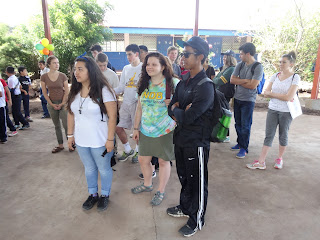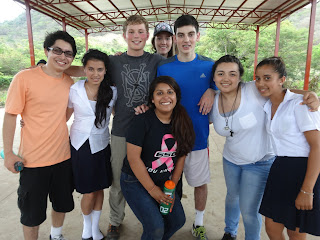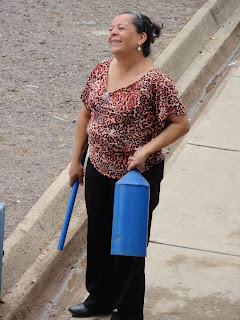On Sunday, in one of the most beautiful
places imaginable, Davie killed his first chicken. There we were, in
what could have been a child's drawing of mountains, the green humps
of hills overlapping forever into the distance. And there was Davie,
standing in front of a clump of chickens strung up by their feet on a
tree branch, surrounded by Nicaraguan friends urging him on. It was
the perfect paradigm: death in the midst of so much life.
Our friend Fatima, who works at the
pharmacy next to our house, had been inviting us to kill chickens
with her for quite a while. Last year she and three other women
started a small poultry business as part of a class assignment for
one of her agriculture classes. When they realized that there was a
real demand for locally-grown chicken in this community, the group of
women continued the business even after the class was over.
We have been buying Fatima's chicken
when they slaughter a round of them every other month. It's good
meat, tender with a strong chicken flavor. So we decided it was time
for us to dispel the meat-eater's vague illusions about where meat
really comes from. With this conviction in mind, we put on our boots
and stomped bravely off to the farm.
When we got there, we realized that
boots weren't the only chicken-killing articles we should have put
on. We had assumed that there would be plastic aprons or ponchos at
the ready, but everyone else was just wearing normal clothes, now
completely covered in blood and chicken feathers.
Fatima showed us the
different stations of the process. The 100 or so chickens that would
be killed that day were held in a small building, where Fatima's
brother was weighing each live chicken and then stuffing them into a
big burlap sack. At six weeks of age, they all weighed around seven
pounds, with the males weighing slightly more and the females
slightly less. Fatima told me that this particular kind of chicken
doesn't lay eggs. (Though I wondered if that was just because they
were too young to lay eggs). They buy the chicks from a vendor in
Esteli and feed them a mix of grains until they are large enough to
slaughter.
The next step in the process was of
course the most dire: slaughter. They took the chickens over to a
structure made of three small tree branches tied together like a goal
post and hung the chickens from their feet on the horizontal pole.
Fatima took a knife and quickly slitted a chicken's throat. It
flapped around a bit as the blood drained out of its neck, but it
made less of a ruckus than I had expected. Then it was Davie's turn.
He drew the knife once and then again across the chicken's throat,
and then it was over. The chickens flapped about for a bit, spewing
blood across their white feathers before finally going still. A dog
lapped up the blood that trickled down the rocks below the dead
chickens. (Later I saw a few egg-laying hens pecking about this same
blood).
After the chickens were dead, they
submerged them in a big pot of boiling water to remove the feathers.
Then they took them into a sort of kitchen. After soaking them in ice
water and picking off any remaining feathers, an assembly line of
four or so people cut open the chickens and removed their organs.
Some of the organs they kept (the liver, the heart, and the gullet),
but the intestines they discarded. Then the chickens were divided
into the various cuts that customers request – wings, breasts,
legs, etc. For me, watching these whole chickens being hacked and
gutted and taken apart was maybe the grossest part of the process.
That night for dinner we made ourselves
some fresh-killed, honey-baked chicken, and it was delicious.
Amazingly, after all that, I was no less disgusted to bite into a
juicy bit of meat that only hours before had been a living animal. I'm not saying that eating meat is necessarily a good habit, but at
least now I understand it a little better.























